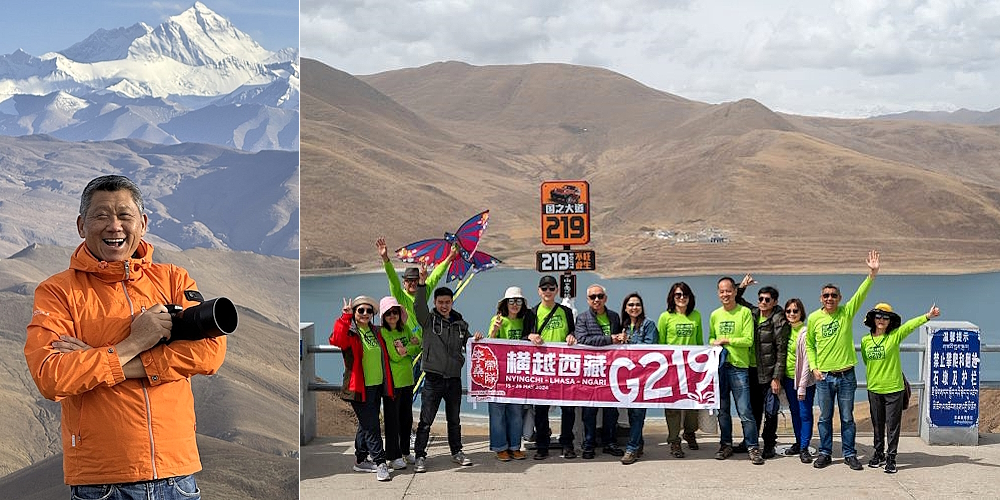
I got to meet up with Tibetan tour guide Feng Jun in post-pandemic Lhasa after a lapse of seven years. Indeed, it was not easy braving through those few hard years, and I would say travel operators who manage to survive the ordeal are indeed true winners in this battle!
I really admire Feng Jun’s professionalism as a tour guide. With well over two decades of industrial experience, he is still deeply passionate about his job today, treating it with utmost seriousness and enthusiasm. He would treat every group he takes as if it is his very first. Such an attitude needs to be emulated by all newcomers to this industry.
On this beautiful day in the month of May, the two of us joined hands to take a group of 15 travel buddies riding in six 4WDs along G318 national highway before turning into the 5,000 km north-south G219 trunk road towards western Tibet.
Among the highlights of the route are Mount Everest, the Everest base camp, the sacred Mount Kailash, and the uninhabited Ngari prefecture, among others — destinations rarely visited by domestic or international tourists.
Occupying one-eighth of China’s total land mass, Tibet is perched at an average altitude in excess of 3,000 metres. And because of that, the biggest concern among visitors is understandably altitude sickness, in addition to ultra high UV radiation.
During this trip, we made our way in the westward direction along the borders with India and Nepal. On our left is the 2,500 km long Himalayas with an average altitude over 4,000 metres, and at least five peaks above 8,000 metres.
Such extreme topography and dry climate have resulted in unusually low atmospheric oxygen concentration in the region of 15 to 19%, whereas oxygen concentration in the lowlands is around 21 to 23%. At the same time, the human blood oxygen concentration will also drop to 60 to 72% (normal levels between 90 and 95%). Generally speaking, symptoms of altitude sickness such as headache, body numbness, breathing difficulty, nausea, sleeplessness and shock may appear depending on individuals.
As a precaution, we had a doctor onboard to take care of the travel buddies, closely monitoring everyone’s conditions in response to rising altitude.
I need to specifically mention here that Tibet, known as the Third Pole of the Earth, is a sacred destination many people will attempt to visit at least once in their lifetime, to have their souls cleansed, despite the tough journey. In the face of all kinds of environmental challenges, we have learned to adopt an easy -going attitude now that we have made the trip here.
Moreover, the most iconic part of the entire journey is Highway G219 touted as the most scenic highway in the whole of China, spanning more than 10,000 km from Dongxing in Guangdong province to Xinjiang through Yunnan and Tibet, passing through deserts, glaciers and mountain ranges, full of excitement, surprises and lurking risks. The 16-day adventure starts with Linzhi, where tourists get to acclimatise themselves for the ultra low atmospheric oxygen concentration, before venturing further.
After we set off from Lhasa in 4WDs, we travelled along G318 towards Shigatse, Tibet’s second largest city. From an altitude of 3,668 metres, we made our way up to Karola Glacier at 5,020 metres, as oxygen became increasingly thinner. Even then, we still carried on with our journey towards the towering mountains to the west.
As a matter of fact, the quality of China’s national highways has reached the highest international standards. Despite the many dangerous curves along the highway, the road surface is impeccably smooth and well maintained. In addition, the scenery was absolutely stunning on this beautiful May day, pristine white clouds hovering above in the azure blue sky, significantly boosted by the dramatic seasonal changes all within a single day.
Along G318, we could see a number of tiny Tibetan hamlets with women going on their daily chores outside their homes, care-free children frolicking around, and shepherds herding their sheep and yaks on the grassland… What a soothing sight!
Did you know that the Tibetans love ghee and that butter tea is an indispensable item in their daily meals? It was said that the Tibetans did not live very long in the past but this has significantly improved today, thanks to better environment and diet, with many living up to an age of 65 and above.
I left the car window open throughout the journey and would occasionally wave at the Tibetans along the way. However, the Tibetans are intrinsically conservative people and would normally respond to my greetings lowering their heads.
Progressing towards the west, the 2,500 km long Himalayas eventually showed up on our left, a majestic sight with the clear blue sky dotted with layer after layer of towering peaks. We did our homework and knew that not far from here at the border with Nepal we would be greeted by a lofty giant over 8,000 metres high, known as the hub of the Earth’s third pole — the Everest!
May is indeed an excellent time to visit Tibet and ascend the northern as well as southern slopes of Everest. The moment we drove into the 33,800 square kilometre Everest National Protection Zone, Mount Everest showed up in front of us, as expected.
The world’s highest peak at 8,848.86 metres above sea level appeared so near within our reach! On the southern slope of Mount Everest in Nepal, there is a base camp which is a hive of activity every May, while the northern slope is located within Tibet, where there are two base camps at approximately 5,300 metres above sea level and 19 kilometres from the summit in a straight line.
Notably, we could drive up to the travel centre located 25 kilometres outside the base camp, where we would change to an eco vehicle towards the world-famous Everest Base Camp 40 minutes away, for a closer encounter with Mount Everest.
Feng Jun told us: Tourists can access both the northern and southern slopes, but the summit is inaccessible to most people. Even so, being able to set foot on the 5,300 metre high base camp is already something we can cherish for an entire lifetime for most people like us!
The Tibetans are very religious people, and they have a lot of respect for the mountains, rivers and Nature. To them, Mount Everest is a sacred mountain that they hold in high esteem. That said, there is another mountain called Mount Kailash which signifies the real soul of the Tibetans.
Ngari, our next stop, will soon see devout Tibetans performing their prostration rituals in a bid to improve their fates. Are you going to join us there?
(Lee San is Founder and Group Executive Chairman of Apple Vacations. He has travelled to 132 countries, six continents, and enjoys sharing his travel stories and insights. He has also authored five books.)
ADVERTISEMENT
ADVERTISEMENT








































